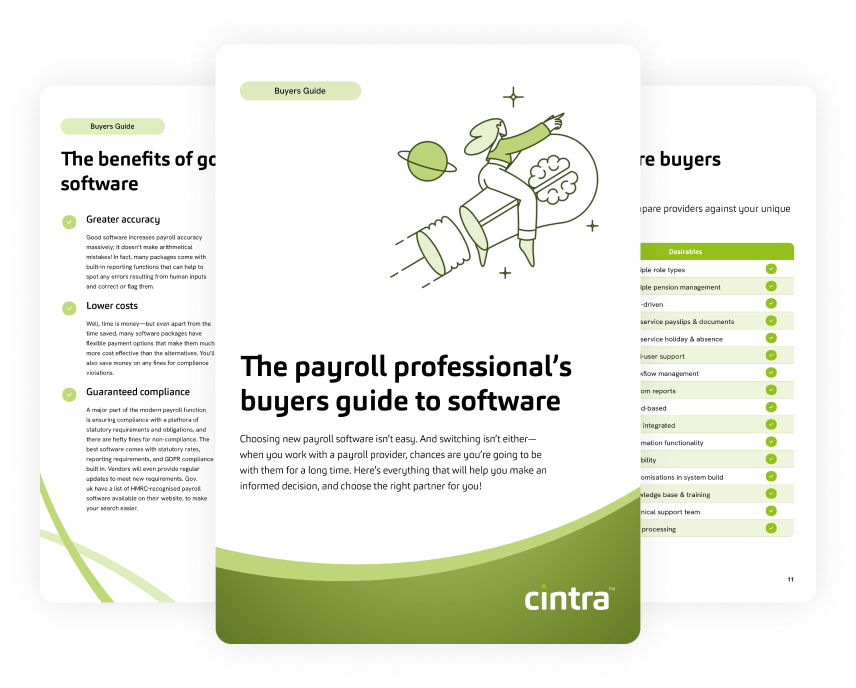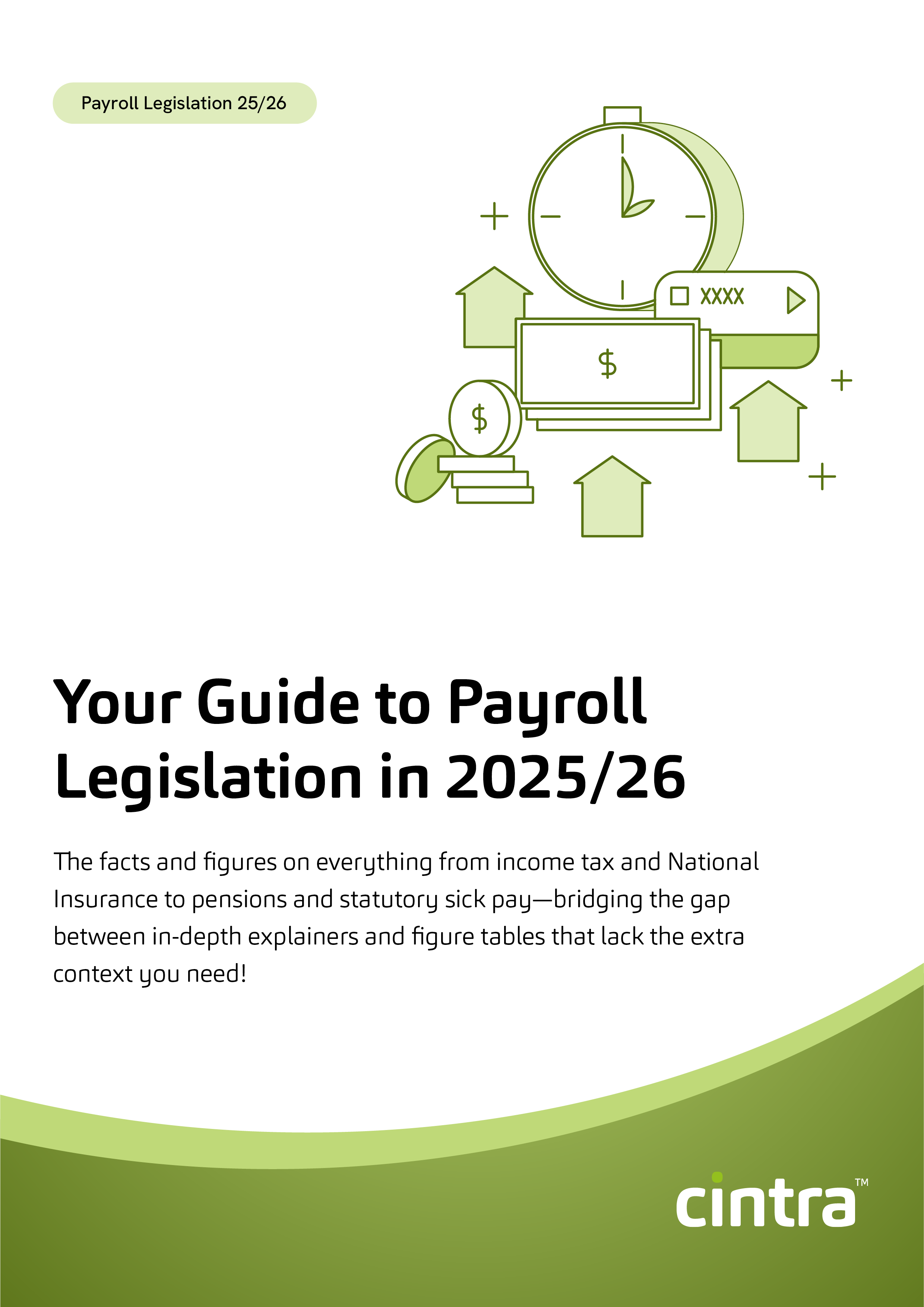Going to market for new payroll software can be really intimidating. We understand; you’ve probably got a lot of questions. Why is there so many different platforms? What is really the difference between them all? How much will it set us back? Is it actually going to deliver everything it promises?
Help is at hand. This is a guide to all the key areas you need to consider when looking for payroll software, designed to shed a little light on how simple your payroll software search could be!
What is payroll software?
Payroll software is a solution for organisations that manage their own payroll in-house. They’re ultimately built to give you all the tools you need to manage your payroll without any external support, and automate complex and time-consuming tasks. The right platform with make it simpler to manage payments, deductions, and employee data accurately and efficiently, with core functionality like:
- Automated calculations: across wages and salaries based on pay rates and hours worked, as well as statutory schemes like sick pay and maternity pay.
- Automated deductions: for taxes, national insurance, student finance, and other statutory contributions that are required by your teams.
- Manage bonuses, benefits, and expenses: to bring everything together under one roof, making it easier for you to guarantee accurate payments and various types of HMRC reporting.
1. On-premise payroll software
On-premise payroll software is installed directly on your organisation’s servers or computers. In the early days of payroll technology, this was the standard option. All data is stored locally, meaning it can only be accessed from within your workplace.
- Security: Since data is stored on-site, you have complete control over who can access it. However, the responsibility for securing the data and ensuring regular backups falls on your IT team.
- Manual updates: Software updates and new features must be installed manually, often requiring IT support. This can add to ongoing maintenance costs and downtime.
- Limited flexibility: Because the software is installed on specific machines, it’s generally accessible only from those devices. For some businesses, this is acceptable, but for others, especially those with remote or hybrid teams, it may feel restrictive.
2. Cloud-based payroll software
Cloud-based payroll software stores all your payroll data on secure online servers, providing access to your team from anywhere with an internet connection. This option has gained popularity due to its flexibility, ease of access, and reduced IT demands.
- Anywhere, anytime access: Cloud-based software allows your teams to access payroll information and complete tasks from any device with internet access, making it ideal for remote or distributed teams.
- Automatic updates: Unlike on-premise software, cloud-based solutions get automatic updates and new features as soon as they are released. This improves your compliance with the latest regulations and minimises disruptions when updates are being installed.
- Scalability: Cloud solutions can scale easily as your company grows, offering flexible pricing and the option to add or remove features as needed.
- Security: Data is stored on encrypted, secure servers hosted by the software provider. Reputable providers—like Cintra—offer robust security measures, that meet your industry’s data protection standards. Common accreditations to look for in a provider include ISO27001 & 9001, Cyber Essentials Plus, HMRC recognition, and CIPP Payroll Assurance Scheme.
So, what can payroll software do for you?
With so much functionality available in payroll software, sometimes you can’t see the wood for the trees. It’s easy to get hung up on areas that aren’t the most important to your needs, so here are the key things that good payroll software should be able to do for you on a practical level:
1. Store employee data
2. Calculate pay and deductions automatically
3. Handle multiple roles and pensions
4. Make employee payments
On time, every time. Whether it’s weekly or monthly, when payday finally comes, everyone loves the payroll team.
Payroll software can streamline payday for accurate payments, on schedule. Some software generates a payment file that can be uploaded directly to your bank, while others can integrate with BACS for direct submission—no manual entry required.
5. Generate and distribute payslips
6. Enable employee self-service
7. HMRC compliant reporting
8. Simplify auto-enrolment for pensions
9. Manage date-driven pay adjustments
What are the benefits of using good payroll software?
Accurate employee pay
Payroll software is going to do all the number-crunching. It can handle all the statutory rates you need to calculate. All those statutory deductions will be managed for you. Meaning you stay headache free, and employees stay happy. Choosing a self-service option also means that any holiday or sickness absence can be accurately managed by employees, and it will be reflected in your payroll system automatically; so your payroll team never have to do manual calculations and deductions.
Total HMRC Compliance
In payroll, compliance rules. Although your compliance responsibility still lies with you, it’s key that whichever payroll software you do choose offers you full compliance. With ‘patches’ that roll out automatically when legislation changes you will always be up to date with the latest regulations. Of course, we can’t remove the responsibility completely, but the software will help you know you are getting it right.
You can double check that you’re making the right choice before you invest—HMRC have a payroll software directory of all platforms that are compliant.
A happy team
With the right payroll software solution, a potentially complex monthly routine becomes a simple one. Any employee pay, no matter how complicated, will be calculated accurately, leaving everyone confident that things are being handled in the most timely, compliant, and efficient way. Which is great for the finance team.
And if you choose to go down the self-service route, the impact on the organisation will be pretty far-reaching. Employee self-service = all the right data + anywhere, anytime access for all employees + automated workflows. Which all adds up to equal a happy workforce.
And once you integrate with your HR software, the possibilities are almost endless.
Time saved
With all this automation, your experts are freed up to deal with the more interesting parts of their job. No more time spent calculating and recalculating spreadsheets, shuffling pieces of paper from one employee to another, or endless chasing for up-to-date employee details.
And if you’ve gone for the fully integrated payroll and HR option… HR will enter new employee’s personal data into your HR system which then pulls straight through to payroll. So, you never have to spend time onboarding and offboarding employees to your payroll.
Simplified complex payroll
Managing payroll can be stressful, especially with complex pay structures, compliance rules, and data security requirements. Payroll software reduces this stress by handling statutory rates, reporting needs, and GDPR compliance, keeping your payroll accurate and on track without manual intervention.
Quick access to insights
The pressure is on HR and payroll teams to provide execs with insights into all kinds of data. They might want you to spot absence trends, provide reports on pay variance, pension and benefit claims, or mileage claims. Or any other concern that is on their agenda.
The good news is that with your new payroll software that’s only a click away. The built-in reports offer you incredible analytics. And if the report you are looking for isn’t there, you should be able to create custom reports that meet your needs.
What are the risks of using bad payroll software?
The benefits are clear. There are so many ways that payroll software is going to make life easier, as long as you have the right software in place. But if you choose an unreliable solution there are a number of things that could go wrong…
Inaccurate pay
Payroll are the unsung heroes of every business. When it’s going right every month, no one thanks their payroll team. But when things go wrong, people speak up and point out the mistakes immediately. And understandably so—not many people work ‘just for the fun of it’.
But when your payroll software is the reason things are going wrong… say your provider didn’t update rates and thresholds after the latest budget. Or they’ve been the victim of a cyber attack so everything is locked-down.
If you work with a software provider that doesn’t have the right systems and processes in place, you’ll not only feel the impact, but your teams and leaders will too.
Non-compliance
Remember we told you that your software will stay up to date with all the legislation? That is a huge benefit, as long as you can trust your software to keep you fully compliant. And good payroll software will. Again, if you’re unsure, check out that HMRC list of compliant packages. Non-compliance is non-helpful.
Security issues
You store a lot of data, about a lot of people. Data that needs to be protected. But hackers are getting more sophisticated. In 2022, 39% of businesses in the UK suffered a cyberattack. That comes at a cost to your organisation, but also to your peace of mind.
So, when you start looking for your payroll solution, check out password protocols, the quality of the infrastructure and any accreditations. If you want the best look for ISO 27001, HMRC approval, or the Payroll Assurance Scheme.
Integration dis-integration
Integration is your friend. Is there any point in getting a great HR system, and all-singing, all-dancing payroll software that don’t talk to each other?
Especially when manual data entry across multiple systems is prone to errors. Which means more admin work. And less time spent on the things that matter.
With single point of data entry, automated workflows, and employee self-service, you can free yourself up to spend your time on bigger and better things.
Useless analytics
The abacus, the slide-rule, and the scientific calculators were all cutting edge once. These days, measuring data is a little more refined.
You need powerful reporting tools to provide your organisation with the edge they need to stay ahead of the curve. Make sure whichever payroll solution you choose has analytics that will give you what you need at the touch of a button.
Ready to look for a new payroll software?
We love to talk about payroll. We spend a lot of time and energy making sure we are one step ahead. And We’re proud of the new features and updates in our market-leading software.
So why don’t you get in touch, and we can discuss all the ways Cintra Pay can keep you ahead of the game?
- Simple, automated processes
- Powerful Insights
- Absolutely compliant and secure
- Top class multi-user support
If you like the sound of all that, just book a demo to take a closer look

Payroll Software Buyers Guide
Download your payroll software buyers guide—covering everything you need to know in your buyers journey, including a handy checklist.
Download your buyers guide


